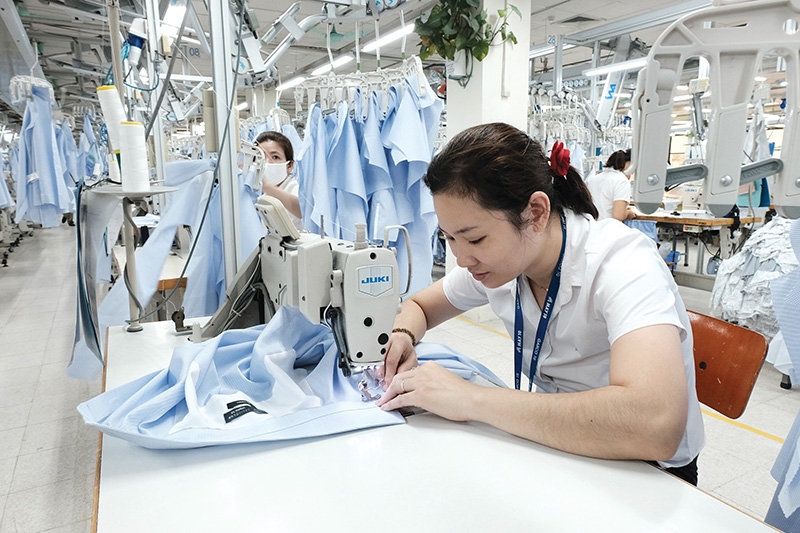Growth goals remain on track as coronavirus rears head
 |
| Credit growth targets are being set to spur on local production and business activities. Photo: Dung Minh |
Prime Minister Nguyen Xuan Phuc last week ordered that all efforts must be made to control the pandemic and ensure the economy will grow 2.5-3 per cent this year.
“We must continue consistently implementing the dual task of combating the pandemic and recovering the economy. This task will not only be carried out in December, but also in the time to come,” PM Phuc stated.
The order was issued following the detection of a few new COVID-19 cases in Ho Chi Minh City, ending an 88-day streak without community infections.
The prime minister also ordered the halt of all inbound commercial flights, stating that the government will only allow repatriation flights for overseas Vietnamese people in the case of difficulties and genuine necessity. All passengers coming back to Vietnam have to be isolated for 14 days.
He also requested a halt to non-essential public activities and all crowded activities, if necessary, have to observe strict anti-viral measures. Social distancing must be applied in areas highly prone to COVID-19 – not all areas nationwide – to minmise impact on local production and business activities.
In order to spur on local production and business, the government asked the State Bank of Vietnam to direct commercial banks to offer preferential loans to firms, with efforts to be made to reach a credit growth rate of over 10 per cent. “Credit growth will help spur on local production and business activities,” the prime minister noted.
In order to support businesses, the Ministry of Planning and Investment, the Ministry of Labour, Invalids, and Social Affairs, and other relevant ministries and agencies are deploying a package to support the sectors of aviation and tourism which are the most seriously hit by COVID-19.
According to the World Bank, while the domestic economy appears to be on track for solid and broad-based recovery in 2020, continuing COVID-19 waves in the rest of the world could dampen Vietnam’s growth prospects. The severe economic and livelihood losses due to recent natural disasters have also highlighted the need to build better and greener, and to make the economy and public finance more resilient to climate change. The bank forecast that Vietnam’s economy may grow 2.5-3 per cent this year, with inflation to be kept below 4 per cent.
A few weeks ago, the International Monetary Fund (IMF) released a forecast on the economic outlook of the global economy in 2020, stating, “Thanks to Vietnam’s swift actions to contain the health and economic fallout of COVID-19, growth this year is expected to be 2.4 per cent, among the highest in the world.”
The IMF also projected that this year the Vietnamese economy will rank fourth in Southeast Asia, with a scale of $340.6 billion, bigger than that of Singapore ($337.5 billion) and Malaysia ($336.3 billion), and lower than that of Thailand ($509.2 billion), the Philippines ($367.4 billion), and Indonesia ($1 trillion).
According to the World Bank, close attention should be paid to the capacity of the Vietnamese economy to firm up its recovery from the coronavirus crisis.
The bank said that on the one hand, near-elimination of restrictive and social distancing measures within the country as well as rising domestic demand fuelled by higher public investment and easing credit conditions should stimulate domestic economic expansion.
On the other hand, the deterioration of the health and economic conditions in the rest of the world may affect Vietnam’s external sector. Also, severe life and economic losses due to the October storms highlight the need to make the economy and public finance more resilient to climate change.
What the stars mean:
★ Poor ★ ★ Promising ★★★ Good ★★★★ Very good ★★★★★ Exceptional
Related Contents
Latest News
More News
- Double-digit GDP growth within reach with shift to higher-value expansion (January 06, 2026 | 08:33)
- Takeda Vietnam awarded for ongoing support of Vietnam’s sustainability efforts (December 31, 2025 | 21:00)
- Vietnam's retail market tops $269 billion in 2025 amid e-commerce boom (December 31, 2025 | 19:00)
- Stronger legal framework urged as trade fraud surges online (December 31, 2025 | 18:58)
- FPT exports first chip shipment to Japan (December 31, 2025 | 10:47)
- AkzoNobel rolls out sustainability campaign “It All Adds Up” for the wood sector (December 31, 2025 | 09:23)
- Textile apparel firms deliver robust earnings despite global tariff pressures (December 30, 2025 | 10:09)
- Businesses ramp up production as year-end orders surge (December 30, 2025 | 10:05)
- Vietjet chairwoman awarded Labour Hero title (December 29, 2025 | 13:06)
- How to unlock ESG value through green innovation (December 29, 2025 | 10:03)

 Tag:
Tag:



















 Mobile Version
Mobile Version